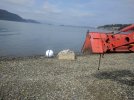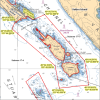jcon12
Well-Known Member
Hi guys,
I plan on dropping a 250lb (pyramid style) mooring anchor this offseason at our place on ruxton island.
The depth will be approx 15-20ft at low tide.
Any advice on a way I can transport and lower the anchor myself? I am almost considering building a small raft with a cutout in the middle and bolting down a cradle with a block/pulley to lower it with... and a few friends to hold on.
I plan on dropping a 250lb (pyramid style) mooring anchor this offseason at our place on ruxton island.
The depth will be approx 15-20ft at low tide.
Any advice on a way I can transport and lower the anchor myself? I am almost considering building a small raft with a cutout in the middle and bolting down a cradle with a block/pulley to lower it with... and a few friends to hold on.






